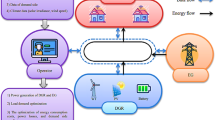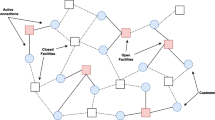Abstract
A two-stage stochastic program is formulated for day-ahead commitment of thermal generating units to minimize total expected cost considering uncertainties in the day-ahead load and the availability of variable generation resources. Commitments of thermal units in the stochastic reliability unit commitment are viewed as first-stage decisions, and dispatch is relegated to the second stage. It is challenging to solve such a stochastic program if many scenarios are incorporated. A heuristic scenario reduction method termed forward selection in recourse clusters (FSRC), which selects scenarios based on their cost and reliability impacts, is presented to alleviate the computational burden. In instances down-sampled from data for an Independent System Operator in the US, FSRC results in more reliable commitment schedules having similar costs, compared to those from a scenario reduction method based on probability metrics. Moreover, in a rolling horizon study, FSRC preserves solution quality even if the reduction is substantial.

















Similar content being viewed by others
References
3TIER Inc (2013) Private communication. http://www.3tier.com/en/
Beltratti A, Consiglio A, Zenios SA (1999) Scenario modeling for the management ofinternational bond portfolios. Ann Oper Res 85:227–247
Bertocchi M, Moriggia V, Dupačová J (2000) Sensitivity of bond portfolio’s behavior with respect to random movements in yield curve: a simulation study. Ann Oper Res 99(1–4):267–286
Botterud A, Zhou Z, Wang J, Valenzuela J, Sumaili J, Bessa RJ, Keko H, Miranda V (2011) Unit commitment and operating reserves with probabilistic wind power forecasts. In: PowerTech, 2011 IEEE Trondheim. IEEE, New York, pp 1–7
Bouffard F, Galiana F, Conejo A (2005) Market-clearing with stochastic security-part I: formulation. IEEE Trans Power Syst 20(4):1818–1826
Bouffard F, Galiana F (2008) Stochastic security for operations planning with significant wind power generation. IEEE Trans Power Syst 23(2):306–316
Carino D, Myers D, Ziemba W (1998) Concepts, technical issues, and uses of the Russell–Yasuda Kasai financial planning model. Oper Res 46(4):450–462
Carøe C, Schultz R (1998) A two-stage stochastic program for unit commitment under uncertainty in a hydro-thermal power system. Technical report, Konrad-Zuse-Zentrum fur Informationstechnik, Berlin, pp 98–13
Carpentier P, Gohen G, Culioli J-C, Renaud A (1996) Stochastic optimization of unit commitment: a new decomposition framework. IEEE Trans Power Syst 11(2):1067–1073
Carrión M, Arroyo JM (2006) A computationally efficient mixed-integer linear formulation for the thermal unit commitment problem. IEEE Trans Power Syst 21(3):1371–1378
Constantinescu E, Zavala V, Rocklin M, Lee S, Anitescu M (2011) A computational framework for uncertainty quantification and stochastic optimization in unit commitment with wind power generation. IEEE Trans Power Syst 26(1):431–441
Corbus D, King J, Mousseau T, Zavadil R, Heath B, Hecker L, Lawhorn J, Osborn D, Smit J, Hunt R et al (2010) Eastern wind integration and transmission study. NREL. http://www.nrel.gov/docs/fy09osti/46505.pdf, CP-550-46505
Dempster M, Thompson R (1999) EVPI-based importance sampling solution proceduresfor multistage stochastic linear programmes on parallel mimd architectures. Ann Oper Res 90:161–184
Dupačová J, Consigli G, Wallace SW (2000) Scenarios for multistage stochastic programs. Ann Oper Res 100(1):25–53
Dupačová J, Gröwe-Kuska N, Römisch W (2003) Scenario reduction in stochastic programming: an approach using probability metrics. Math Program 95(3):493–511
Feng Y, Ryan SM (2013) Scenario construction and reduction applied to stochastic power generation expansion planning. Comput Oper Res 40(1):9–23
Feng Y, Rios I, Ryan S, Spürkel K, Watson J, Wets R, Woodruff D (2014) Scalable stochastic unit commitment—part 1: scenario generation (Under review)
Fleten S-E, Wallace SW (2009) Delta-hedging a hydropower plant using stochastic programming. In: Optimization in the energy industry. Springer, Berlin, pp 507–524
Pflug G, Pichler A (2012) A distance for multistage stochastic optimization models. SIAM J Optim 22(1):1–23
Gröwe-Kuska N, Heitsch H, Römisch W (2003) Scenario reduction and scenario tree construction for power management problems. In: IEEE Bologna power tech conference proceedings
Heitsch H, Römisch W (2003) Scenario reduction algorithms in stochastic programming. Comput Optim Appl 24(2):187–206
Heitsch H, Römisch W, Strugarek C (2006) Stability of multistage stochastic programs. SIAM J Optim 17(2):511–525
Heitsch H, Römisch W (2007) A note on scenario reduction for two-stage stochastic programs. Oper Res Lett 35(6):731–738
Heitsch H, Römisch W (2009a) Scenario tree reduction for multistage stochastic programs. Comput Manag Sci 6(2):117–133
Heitsch H, Römisch W (2009b) Scenario tree modeling for multistage stochastic programs. Math Program 118(2):371–406
Heitsch H, Römisch W (2011) Stability and scenario trees for multistage stochastic programs. Stoch Program, pp 139–164. doi:10.1007/978-1-4419-1642-6_7
Henrion R, Küchler C, Römisch W (2008) Discrepancy distances and scenario reduction in two-stage stochastic mixed-integer programming. J Ind Manag Optim 4(2):363–384
Henrion R, Küchler C, Römisch W (2009) Scenario reduction in stochastic programming with respect to discrepancy distances. Comput Optim Appl 43(1):67–93
ISO-NE (2014) Hourly zonal information. http://www.iso-ne.com/markets/hstdata/znl_info/hourly/index.html
Kaut M, Wallace SW (2007) Evaluation of scenario-generation methods for stochastic programming. Pac J Optim 3(2):257–271
Kleywegt AJ, Shapiro A (2002) The sample average approximation method for stochastic discrete optimization. SIAM J Optim 12(2):479–502
Küchler C, Vigerske S (2007) Decomposition of multistage stochastic programs with recombining scenario trees. Stochastic programming E-print series (SPEPS)
Latorre JM, Cerisola S, Ramos A (2007) Clustering algorithms for scenario tree generation: application to natural hydro inflows. Eur J Oper Res 181(3):1339–1353
Mahoney W, Parks K, Wiener G, Liu Y, Myers W, Sun J, Hopson T, Johnson D, Haupt SE (2011) A wind power forecasting system to optimize grid integration. IEEE Trans Sustain Energy 3(4):670–682
Manning C, Raghavan P, Schütze H (2008) Introduction to information retrieval, 1st edn. Cambridge university press, Cambridge
Morales JM, Pineda S, Conejo AJ, Carrion M (2009) Scenario reduction for futures market trading in electricity markets. IEEE Trans Power Syst 24(2):878–888
Morales J, Conejo AJ, Liu K, Zhong J (2012) Pricing electricity in pools with wind producers. IEEE Trans Power Syst 27(3):1366–1376
Nowak M, Römisch W (2000) Stochastic Lagrangian relaxation applied to power scheduling in a hydro-thermal system under uncertainty. Ann Oper Res 100(1–4):251–272
Papavasiliou A, Oren S, O’Neill R (2011) Reserve requirements for wind power integration: a scenario-based stochastic programming framework. IEEE Trans Power Syst 26(4):2197–2206
Papavasiliou A, Oren S (2013) Multiarea stochastic unit commitment for high wind penetration in a transmission constrained network. Oper Res 61(3):578–592
Philpott A, Craddock M, Waterer H (2000) Hydro-electric unit commitment subject to uncertain demand. Eur J Oper Res 125(2):410–424
Römisch W, Vigerske S (2010) Recent progress in two-stage mixed-integer stochastic programming with applications to power production planning. In: Handbook of power systems I. Springer, Berlin, pp 177–208
Ruiz P, Philbrick C, Zak E, Cheung K, Sauer P (2009) Uncertainty management in the unit commitment problem. IEEE Trans Power Syst 24(2):642–651
Sandia National Laboratories (2014) PySP. https://software.sandia.gov/trac/coopr/wiki/PySP
Takriti S, Birge J, Long E (1996) A stochastic model for the unit commitment problem. IEEE Trans Power Syst 11(3):1497–1508
Timonina Anna V (2013) Multi-stage stochastic optimization: the distance between stochastic scenario processes. Comput Manag Sci, pp 1–25. doi: 10.1007/s10287-013-0185-3
Tuohy A, Meibom P, Denny E, O’Malley M (2009) Unit commitment for systems with significant wind penetration. IEEE Trans Power Syst 24(2):592–601
Wang J, Shahidehpour M, Li Z (2008) Security-constrained unit commitment with volatile wind power generation. IEEE Trans Power Syst 23(3):1319–1327
Watson J-P, Woodruff D (2011) Progressive hedging innovations for a class of stochastic mixed-integer resource allocation problems. Comput Manag Sci 8(4):355–370
Watson J-P, Woodruff D, Hart W (2012) PySP: modeling and solving stochastic programs in Python. Math Program Comput 4(2):109–149
Wu L, Shahidehpour M, Li T (2007) Stochastic security-constrained unit commitment. IEEE Trans Power Syst 22(2):800–811
Zheng Q, Wang J, Pardalos P, Guan Y (2013) A decomposition approach to the two-stage stochastic unit commitment problem. Ann Oper Res 210(1):387–410
Acknowledgments
Funding for this work was provided by the US Department of Energy ARPA-e initiative under the Green Energy Network Integration (GENI) program.
Author information
Authors and Affiliations
Corresponding author
Appendix A: Concrete stochastic reliability unit commitment model
Appendix A: Concrete stochastic reliability unit commitment model
1.1 Appendix A.1: Notation
Sets and indices
- \(\mathcal {B}\) :
-
Set of buses
- \(\mathcal {G}\) :
-
Set of thermal units
- \(\mathcal {L}\) :
-
Set of transmission lines, modeled as directed arcs
- \(\mathcal {L}_{I}(b)\) :
-
Set of transmission lines to bus \(b\)
- \(\mathcal {L}_{O}(b)\) :
-
Set of transmission lines from bus \(b\)
- \(\mathcal {K}_g\) :
-
Set of time intervals of stairwise start-up cost function of thermal unit \(g\)
- \(\mathcal {S}\) :
-
Set of scenarios
- \(\mathcal {T}\) :
-
Set of time periods
- \({BF}_{\ell }, {BT}_{\ell }\) :
-
Buses located at the two ends of transmission line \(\ell \), representing the bus injecting power to and absorbing power from line \(\ell \), respectively
Parameters
- \(\xi _s\) :
-
Probability of scenario \(s\)
- \(\varDelta _{g}^{ru}\) :
-
Ramping-up limit of unit \(g\) (MW/h)
- \(\varDelta _{g}^{rd}\) :
-
Ramping-down limit of unit \(g\) (MW/h)
- \(\varDelta _{g}^{su}\) :
-
Start-up ramping limit of unit \(g\) (MW/h)
- \(\varDelta _{g}^{sd}\) :
-
Shut-down ramping limit of unit \(g\) (MW/h)
- \(\bar{P}_g\) :
-
Capacity of unit \(g\) (MW)
- \(\underline{P}_g\) :
-
Minimum power output of unit \(g\) (MW)
- \(B_{\ell }\) :
-
Negative susceptance of line \(\ell \in \mathcal {L}\)
- \(d_{bts}\) :
-
Net load at bus \(b\) in period \(t\) in scenario \(s\) (MWh)
- \(F_{\ell }\) :
-
Maximum capacity of transmission line \(\ell \) (MW)
- \(H_g^+, H_g^-\) :
-
Time of unit \(g\) has been on, or off at the beginning of scheduling
- \(\varrho _{gk}\) :
-
Startup cost of thermal unit \(g\) for time intervals \(q \in \mathcal {K}_g\) ($)
- \(R_{t}\) :
-
Reserve requirement in period \(t\) (MWh)
- \(T_g^U, T_g^D\) :
-
Minimum up and down times of unit \(g\)
- \(\varGamma _{\alpha }^{+},\varGamma _{\alpha }^{-}\) :
-
Penalties on load imbalance ($/MWh)
- \(\varGamma _{\beta }^{+},\varGamma _{\beta }^{-}\) :
-
Penalties on reserve requirement imbalance ($/MWh)
- \(J\) :
-
Number of blocks of the piecewise linear generation cost function of unit \(g\)
- \(\delta _{jgts}\) :
-
Energy generated in block \(j\) of the piecewise linear generation cost function of unit \(g\) in period \(t\) in scenario \(s\) (MWh)
- \(\lambda _{jg}\) :
-
Slope of block \(j\) of the piecewise linear generation cost function of unit \(g\) ($/MWh)
- \(\gamma _{jg}\) :
-
Upper limit of block \(j\) of the piecewise linear generation cost function (MWh)
- \(a_g\) :
-
No-load cost of unit \(g\) ($)
- \(c_{gt}^{u}(\cdot )\) :
-
Commitment cost function of unit \(g\) in period \(t\) ($)
- \(c_{gts}^{p}(\cdot )\) :
-
Generation cost function of unit \(g\) in period \(t\) in scenario \(s\) ($)
Decision variables
- \(v_{gt} \in \{0,1\}\) :
-
First-stage decision, binary variable, equal to \(1\) if unit \(g\) is on in period \(t\), and 0 otherwise
- \(p_{gts} \ge 0\) :
-
Generation level of unit \(g\) in period \(t\) in scenario \(s\) for \(g \in \mathcal {G}\) (MW)
- \(\bar{p}_{gts} \ge 0\) :
-
Maximum available power generation for unit \(g\) in period \(t\) in scenario \(s\) for \(g \in \mathcal {G}\) (MW)
- \(\alpha _{bts}^{+},\,\alpha _{bts}^{-} \ge 0\) :
-
Auxiliary variables, representing shortage and excess in load supply at bus \(b\) in period \(t\) in scenario \(s\), respectively (MWh)
- \(\beta _{ts}^{+}\), \(\beta _{ts}^{-} \ge 0\) :
-
Ancillary variables, representing shortage and excess in reserve requirement in period \(t\) in scenario \(s\) (MWh)
- \(\theta _{bts}\) :
-
Phase angle at bus \(b\) in period \(t\) in scenario \(s\) (radians)
- \(\omega _{\ell ts}\) :
-
Line power of transmission line \(\ell \) in period \(t\) in scenarios \(s\), unrestricted in sign because power can flow in either directions on a line
1.2 Appendix A.2: Mathematical model
The full concrete formulation of SRUC extends the deterministic UC model in Carrión and Arroyo (2006) to a two-stage stochastic program. The commitments of thermal units are considered as first-stage decisions. Second-stage decision variables include generation level of each unit, and corresponding maximum available generation level. The following presents a two-stage stochastic program by viewing each hour as a period.
1.2.1 Appendix A.2.1: Objective function
The objective function (31) consists of two parts: the cost related to commitments of units, like startup, shutdown and no-load costs; and the cost related to generation and penalties on load and reserve requirement imbalances, upon realization of a scenario in the second stage, as shown in (32).
The goal of SRUC is to minimize total commitment cost, expected generation cost and expected penalties on imbalances in generation and reserve. The following section presents operational constraints.
1.2.2 Appendix A.2.2: Constraints
Energy balance at each bus:
Formula (33) describes the relationship between load demand and generated and net transmitted energy for each bus.
Reserve requirements:
Reserve requirements (34) maintain reliability if contingencies that are not modeled in scenarios occur; e.g., outages of generators or transmission lines.
Line Power:
Power flow in each transmission line is formulated and restricted in (35) and (36). Formulation (35) is a linear, lossless DC approximation of the relationship between phase angles and power flow on a transmission line.
Generation limits:
Available power generation level of a thermal unit depends on its operational status, as in (37). The difference between maximum available generation level \(\bar{p}_{gts}\) and actual generation level \(p_{gts}\) indicates the contribution of unit \(g\) to the reserve requirement in period \(t\) in scenario \(s\). In addition, the maximum available generation level of a thermal unit in a period is coupled by possible generation levels in preceding and succeeding periods.
Ramp rate limits:
Formulas (38)–(40) represent maximum available changes in generation levels of each unit between two consecutive periods.
Minimum up-time constraints:
Minimum down-time constraints:
Thermal units cannot be shut down (started up) immediately after being started up (shut down), because these operations can only be performed under gradual change of temperature, which translates to time periods. Formulas (41)–(46) use binary variables to describe these restrictions on thermal units.
Commitment cost:
The start-up cost function is monotonically increasing along the time of a thermal unit has been off. Stairwise start-up cost function is adopted and formulated in the first term of (47), where \(\mathcal {K}_g = \{k_1, \ldots , k_{\mathcal {N}_g}\}\), and \(\varrho _{gk_i} \le \varrho _{gk_{i+1}}\), \(i = 1, \ldots , \mathcal {N}_g - 1\). Notice that, \(\varrho _{gk}\) includes shutdown cost in the case study. The second term is no-load cost of unit \(g\) which will occur once a unit is committed.
Generation cost function:
Equations (48)–(53) compute piecewise-linear generation costs.
A mixed integer linear program (MILP) extensive form of SRUC has been formulated in (31)–(56) , with boundary defined for each decision variable, as follows.
1.2.3 Appendix A.2.3: Bounds
This model can be easily extended to the situation in which variable generation, such as wind, is viewed as dispatchable resource. Set \(\mathcal {G}\) will include variable energy generators, and \(d_{bts}\) will represent load rather than net load. In formula (37), we can set \(v_{gt}\) to 1 for any variable energy generator \(g\), and allow \(\bar{P}_{g}\) to vary by scenario. Then other constraints will be suitable for variable energy generators.
Rights and permissions
About this article
Cite this article
Feng, Y., Ryan, S.M. Solution sensitivity-based scenario reduction for stochastic unit commitment. Comput Manag Sci 13, 29–62 (2016). https://doi.org/10.1007/s10287-014-0220-z
Received:
Accepted:
Published:
Issue Date:
DOI: https://doi.org/10.1007/s10287-014-0220-z




